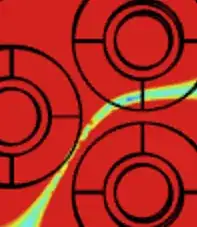I have encountered the following problem regarding the reconstruction of a particle density function $f$. It is possible to acquire "measurements" of the particle density function $f : [0,1]^2 \rightarrow \mathbb{R}^{>0} $. The discrete measurements $m_{i}=\int_{[0,1]^2}f(x) g_{i}(x)dx$ are given by a weighted integral of $f$ with the weighting functions $g_{i}$. The functions $g_{i}$ are known in advance and the task is to reconstruct $f$ numerically given the measurements $m_{i}$.
Unfortunately I cannot give much information about the weighting functions $g_{i}$. They are the output of a computer simulation and I have them sampled on a grid spanning the domain of $f$ (e.g. $[0,1]^2$). Generally speaking, the functions $g_{i}$ look a bit like the picture below where the red color corresponds to $g_{i}(x,y)=0$ and the blue/greenish color corresponds to $g_{i}(x,y)=1$ (please ignore the dark outlines):
Other sampling function are similar to rotated versions of $g_{i}$.
I am wondering if there is a general numerical approach to tackling this kind of problem?

Sampling function $g_{i}$. Red zones correspond to $g_{i}=0$.